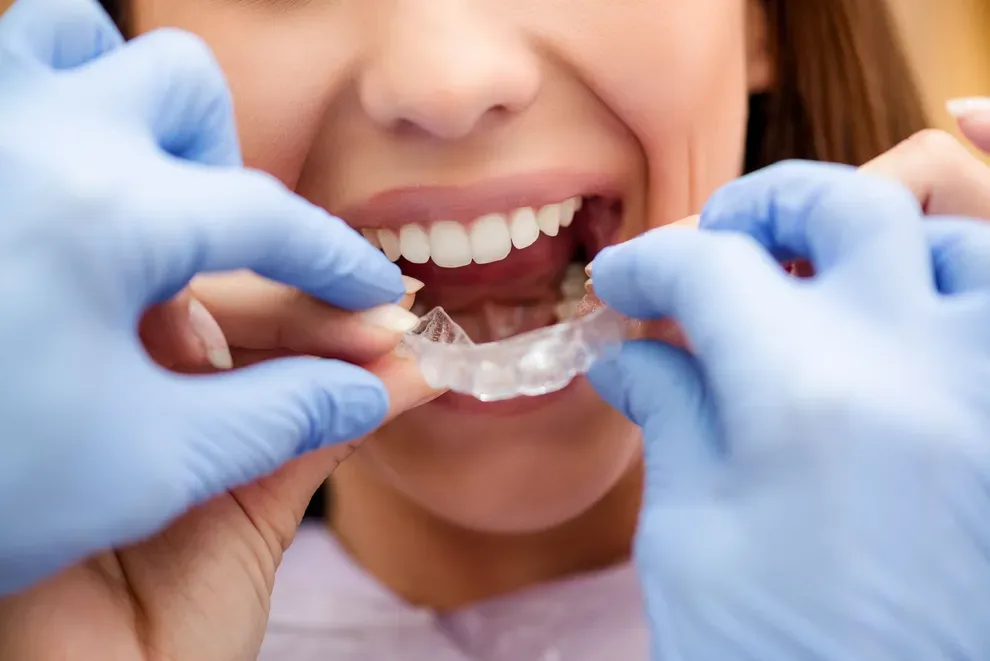Overbite Correction: What Is It & How to Properly Correct It

Table of Contents
- What is an Overbite?
- Key Facts
- Types of Overbites
- What Causes Overbites?
- Symptoms of Overbites
- Overbite Diagnosis
- Treatment Options
- Preventing Overbite
- Overbite FAQs
- References
An overbite is a type of malocclusion, or teeth misalignment. Sometimes an overbite is called buck teeth, a deep bite, or overjet teeth. With an overbite, the upper front teeth extend over the lower front teeth. They may appear to protrude outward.
Overbites are often caused by genetics, but they may also be caused by an accident, childhood behavior (such as pacifier use and thumb sucking), or other oral habits (including nail biting or teeth grinding).
Overbites can affect appearance and self-esteem, but they can also increase the risk of other oral health problems like decay, enamel wear, and gum problems. Some individuals with severe overbites may have to undergo jaw surgery or tooth extraction to correct their issues.
Many people may have the choice of braces treatment, sometimes with the use of orthodontic appliances. Those with mild to moderate overbites may fix their smile and bite with clear aligners, which are available through an orthodontist or online aligner companies that provide a completely remote doctor-supervised treatment plan.
What is an Overbite?
An overbite is a type of teeth misalignment where the upper teeth sit too far in front of the lower teeth.
Overbites are a common type of malocclusion, and not all overbites need correction. In fact, with a normal natural bite, the front teeth sit slightly in front of the lower teeth. But with an overbite, the upper teeth sit too far beyond the lower teeth. This causes alignment problems and can result in issues like crooked teeth, spacing problems, crowding, and tooth abrasion.
Key Facts about Overbite Correction
According to 2018 research completed by the Dental Press Journal of Orthodontics, a global study of children and adults found that approximately 22 percent had an overbite.1
An overbite simply means that the top front teeth extend too far beyond the lower front teeth. An overlap of more than 2 to 3 millimeters is usually considered an overbite in need of treatment.
An overbite is often the result of genetics, but it can also be caused by childhood habits like thumb sucking and pacifier use, oral behaviors like nail biting and tongue thrusting, and injuries and mouth trauma.
Overbite treatment may include jaw surgery, tooth removal, orthodontic appliances, braces, and clear aligners. Some severe cases may require a combination of treatments.
If left untreated, an overbite can cause health problems that include tooth decay, gum disease, tooth damage, jaw disorders, and eating and speech problems.
Types of Overbites
There are different classifications of overbite, including these:
Skeletal overbite: This type of overbite is caused by irregular or problematic jawbone development.
Dental overbite: This is an overbite that is caused by tooth development issues like crowding, missing teeth, poor oral care, or mouth trauma.
Impinging overbite: This is the most severe type of overbite that causes lower teeth to abrasively come into contact with the palate of the mouth. Serious trauma and even a loss of front teeth could occur if left untreated.
Overlapping scale: Orthodontists measure how serious an overbite is by the percentage of overlapping of the top teeth over the lower (10–30 percent). The higher the percentage, the more serious and complex the overbite in question is.
What Causes Overbites?
Like most forms of malocclusion, major causes of all forms of overbite are genetics and hereditary bite and jaw problems.
Other causes may include the following:
Jaw development problems, including jaws that aren’t large enough to allow for teeth to grow in properly
Prolonged use of sippy cups or pacifiers as a child
Teeth grinding
Thumb sucking as a child
Nail biting
Tongue thrusting
An untreated lost tooth
What are the Symptoms of Overbites?
The most obvious symptom of an overbite is the appearance of the teeth. The top front teeth may look like they are protruding out in front of the lower teeth or overlapping too much.
Other symptoms of an overbite include the following:
Problems chewing and biting into foods
Speech problems, including lisps
Mouth breathing
Jaw disorders, including TMJ
Teeth grinding
Difficulty cleaning in between teeth
Tooth decay problems, like cavities
Gum irritation and inflammation
Weakened tooth enamel from abrasion or bad bite patterns
How is an Overbite Diagnosed?
An overbite will be diagnosed by a dentist. They may recognize it as part of your regular exam or after x-rays. Depending upon the severity of your overbite, they may recommend treatment or refer you to an orthodontist.
If you suspect you have a mild overbite, you can also get a mail-order impression kit from a clear aligner company to see if this type of treatment will work for you. If it’s determined that you’re not a candidate, some aligner providers (including Byte) will refund you the cost of the impression kit.
Treatment Options for Overbite Correction
The type of treatment that you’ll need to correct your overbite will depend on how severe your misalignment is and what’s causing it.
Overbite treatments include the following:
If your overbite is due to the position of your jaw or a skeletal issue (skeletal overbite), jaw surgery may be needed to ensure the jaw and mouth can line up together properly. This is especially true for adults with an overbite because adult jaws are already developed and harder to influence with orthodontic devices.
If you have crowding issues due to your overbite, your orthodontist may recommend tooth extraction. If teeth are crowded, there is likely no room for teeth to shift to their proper positioning with orthodontic treatment. With tooth removal, space is made to allow for tooth movement.
If your overbite is caused by teeth shifting after a lost tooth, the missing tooth will need to be treated before your overbite can be fixed. Lost tooth replacement options include dental bridges, dental implants, and dentures.
Braces have long been one of the most popular treatments for overbites. Braces involve brackets that are cemented to the teeth and connected by wires. Your orthodontist tightens these wires during regular adjustment visits in order to apply pressure to the teeth and move them into place.
While the most serious types of overbite may require traditional metal braces (often along with surgery and orthodontic appliances), other types of braces are available, including ceramic “invisible” braces and lingual braces, which attach to the back of the teeth.
Orthodontic appliances may be used alone or in conjunction with other orthodontic treatments (common for adults). These appliances may include headgear, which typically uses wiring inside and outside of the mouth to affect the jaw, or a palatal expander, which is placed on the bottom or roof of the mouth and widens to encourage widening of the jaw.
Clear aligners are removable and custom-made to fit over your teeth and guide them through a progression of movements. With treatment, you transition through a series of aligner trays until teeth have reached their corrected position.
For many people with a mild to moderate overbite, aligners are an appealing treatment option due to their convenience, fast-acting results (many top aligners have an average treatment time of 4–6 months), and affordability.
Can I Prevent an Overbite?
Because many cases of overbite are caused by hereditary factors, there is often nothing that can be done to prevent this type of misalignment.
However, some oral habits can increase the risk of overbite, including prolonged thumb sucking, tongue thrusting, and teeth grinding. Avoiding these habits, especially during childhood and adolescence, can help to prevent overbite in some cases.
Some sippy cups and extended pacifier use can also lead to an overbite. If you’re worried that your child’s oral habits could be causing bite problems, speak to their dentist.
Missing teeth can also cause an overbite and bite problems in general. When a tooth is lost, the other teeth may shift into misalignment. Treating a missing tooth quickly can help to prevent this.
While many cases of overbite cannot be prevented, you can avoid some of the complications from an overbite by doing these things:
Practice good oral hygiene, and take extra care to keep any areas (like narrow passages between the teeth or gaps) clean of bacteria and particle buildup. This can help fight off the decay and gum problems associated with overbites.
Keep up with regular dentist appointments and ensure your dentist is monitoring your overbite situation. Be sure to tell your dentist about any mouth irritation or jaw pain you are experiencing.
Address any jaw or TMJ issues before the problem gets worse.
Consider treatment for your orthodontic problems. Even if your overbite seems minor, correcting it could improve your self-esteem and oral health. Completing an at-home aligner impression kit could help you determine If you’re a candidate for easy at-home treatment.
Overbite Frequently Asked Questions
No. While teeth may shift with age, they will not simply move into correct positions. Only orthodontic treatment can guide teeth into their ideal locations for a corrected smile and bite.
Worrying won’t help anything, but you can be proactive in deciding to take charge of your bite, smile, and oral health. If you feel like you have an untreated overbite, you can see a dentist for x-rays and an exam to determine the extent of the problem. You can also order an at-home impression kit from a clear aligner provider to determine if you’re a candidate for treatment.
No. If you’re aware that you have an overbite, you should seek care to help determine your next steps, whether that’s an orthodontic exam or an at-home impression kit from an aligner provider. Ignoring your overbite will just allow the problem to get worse and could result in problems like tooth decay, gum problems, and jaw disorders.
If you’re aware that you have an overbite, seeking treatment sooner rather than later can help to lower the risk of any complications, like cavities or gum irritation caused by bacteria buildup in hard-to-reach crevices created by the misalignment. Prompt treatment can also help to correct teeth before they shift more.
The length of your treatment will depend on the severity and complexity of your overbite, and the type of treatment you’ve chosen. A very serious overbite being treated by braces and a surgery, for example, could take 2 or more years to correct. A mild-to-moderate overbite being corrected with clear aligners may only take 4 months.
The type of overbite you have and its severity will determine which treatments you’re eligible for. Skeletal overbites, for example, may often involve surgery as part of treatment. For more moderate overbites, braces and clear aligners may allow for a less involved treatment plan.
For those with a mild-to-moderate overbite, clear aligners may be considered the easiest and most efficient treatment. Clear aligners are virtually invisible and can be removed to eat and perform daily hygiene routines. Plus, they generally work more quickly than braces, and some providers allow for a convenient and completely at-home treatment plan.
